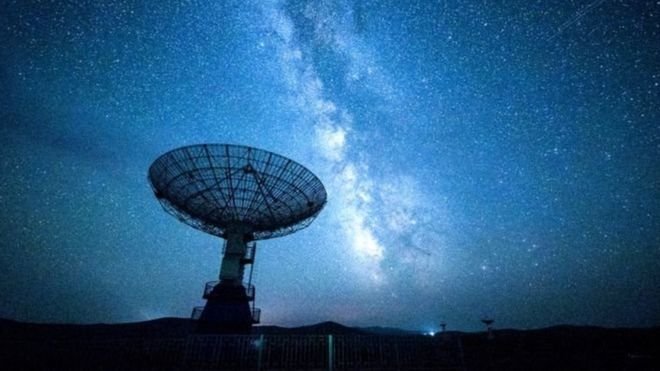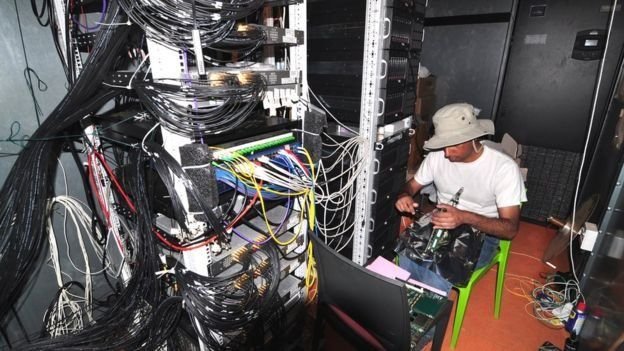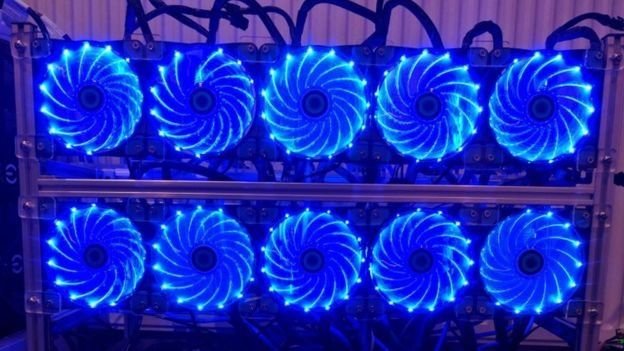
Scientists looking for signs of extraterrestrial life have a big problem. And everything is due to the rise of cryptocurrencies, according to an expert in radio astronomy.
The researchers specialized in the search for extraterrestrial intelligence or SETI in English (Search for Extraterrestrial Intelligence) want to expand their operations in two observatories.
But they face the shortage of a key hardware component.
"We want to use the latest version of graphics cards and we can not find them on the market," radio astronomer Dan Werthimer, a researcher at the Center for Searching for Extraterrestrial Intelligence at the University of California, Berkeley, told the BBC.
Electronic gold fever: what are the best places in the world to "mine" bitcoins (and why)
Why is it worrying that cryptocurrencies can end the banking system?
Graphic cards, also called graphic processing units or GPUs for short, are co-processors of graphics used to lighten the load of the central processor or CPU in applications such as video games.
But the demand for graphics cards has skyrocketed due to cryptocurrency mining.
"This phenomenon is limiting our search for extraterrestrial life and our efforts to answer questions like are we alone in the universe?" Werthimer told the BBC.
"This problem is new, we have faced it in the purchase orders in the last two months."
What is the cryptocurrency whose value grew almost 800% in a month (and is not the bitcoin)
Miners and radio astronomers
Mining or getting a coin like Bitcoin or Ethereum requires connecting computers to a global network and using them to solve complex mathematical problems.

These actions are part of the validation process of the transactions carried out by those who use the cryptocurrency.
And as a reward for their work, the miners receive a payment in crypto currencies earning profits.
Graphics cards, on the other hand, are high performance chips that are not only used in video games.
They can be combined to mine cryptocurrencies and are used by radio astronomers and others interested in processing large amounts of data.
"In the case of the search for extraterrestrial intelligence we examine as many frequencies as possible because we do not know in which of them ET can communicate," Werthimer said.
"Will you use AM, FM or any other type of communication? We should look at many different types of signals and that requires enormous computing power."
"They're sold out"
Werthimer explained that in the case of some telescopes, the University of Berkeley uses about 100 graphics cards to analyze data.

These are telescopes capable of capturing radio frequencies from very distant places outside the Solar System and phenomena such as the collapse of stars.
Werthimer and his colleagues at UC Berkeley are trying to expand the data analysis capabilities of two observatories, Green Bank in the state of West Virginia in the United States, and Parkes in Australia.
The big problem is the lack of graphics cards.
"We have the money, we contact the sellers, but they tell us they sold out."
An executive at Nvidia, one of the leading chip companies, said last week in a conference with his investors that the company "is working very hard" to respond to the demand for graphics cards in the market.
First stars
Other radio astronomers have also been affected.
A group of scientists looking for evidence of the first stars of the universe was recently surprised to find that the cost of the graphics cards had doubled.
"We received funds from the National Science Foundation of the United States and we want to expand our telescope," said Aaron Parsons, a professor at UC Berkeley.
The telescope that Professor Parsons refers to is known as HERA, a radio telescope located in South African territory that is a collaboration between the United States, the United Kingdom and South Africa.
The telescope was designed to capture very low frequencies of radio waves emitted by the reionized hydrogen gas that permeated the universe in its early stages.

The graphics cards are necessary to join the data of the many Hera antennas.
Three months ago, Hera researchers had budgeted the necessary spending for a set of graphic cards of US $ 500 each. But the current price of each card is US $ 1000.
"We bought many of those cards and now we need an extra US $ 32,000," said Parsons.
The scientist expressed concern about the possibility that some projects should be suspended altogether if the shortage of graphic cards is exacerbated.
Meteoric rise
Thanks in part to the recent boom in cryptocurrency prices such as Bitcoin and Ethereum, mining these virtual currencies has become more popular than ever.
The Bitcoin miners have gone on to use mostly Asic chips, special for operations of this type.
But it's still possible to use graphics cards to profit by mining Ethereum, according to Mathew Hick, a cybersecurity expert at Hacker House.
"You can use GPU graphics cards to get a small profit, you will not earn millions, but if you operate with 12 or 24 graphics cards, you recover in six months what you invested in the chips."
Hick pointed out that graphics cards are versatile. The experts in cybersecurity use them when they test the security of passwords trying to decipher them, with computers that make millions of attempts with different combinations ".
Hick said that graphics cards are now sold on sites like Ebay "at inflated prices."
"And it's getting harder and harder to find suppliers and cards."